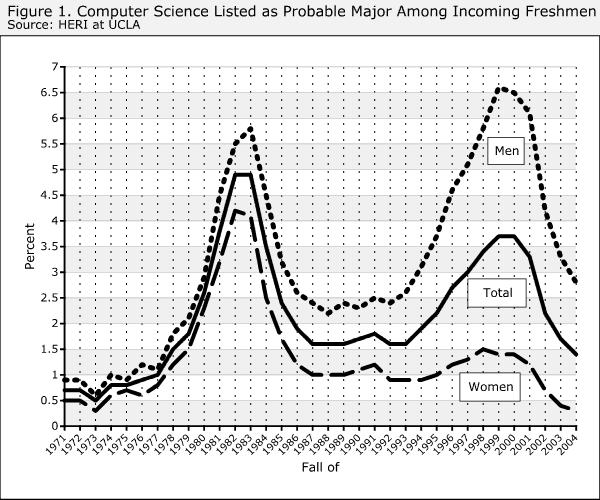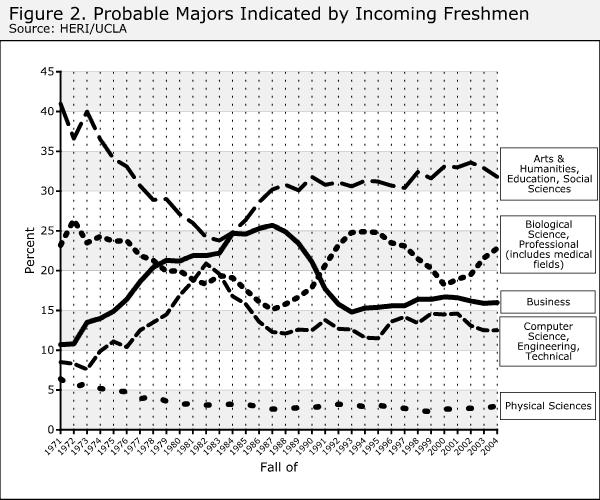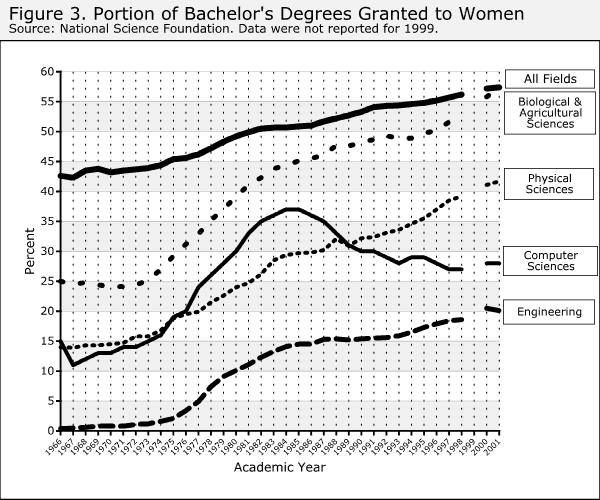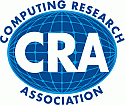<< Back to May 2005 CRN Table of Contents
[Published originally in the May 2005 edition of Computing Research News, Vol. 17/No. 3]
See also the March 2006 article, Drop in CS
Bachelorís Degree Production.
and
Interest in CS and CE as
Majors Drops in 2005
and
Freshmen Interest in CS
and Degree Production Trends
Interest in CS as a
Major Drops Among Incoming Freshmen
by Jay Vegso
An analysis of survey
results from the Higher Education Research Institute at the University of
California at Los Angeles (HERI/UCLA) indicates that the popularity of
computer science (CS) as a major among incoming freshmen at all
undergraduate institutions has dropped significantly in the past four
years. Alarmingly, the proportion of women who thought that they might
major in CS has fallen to levels unseen since the early 1970s.
The
percentage of incoming undergraduates indicating that they would major in
CS declined by over 60 percent between the Fall of 2000 and 2004, and is
now 70 percent lower than its peak in the early 1980s (Figure
1).

Freshmen interest levels at any given
point have been an accurate predictor of trends in the number of degrees
granted four to five years later. It therefore seems likely that there
will be a sharp decline in the number of bachelor's degrees granted in CS
in the coming decade. Results from CRA's Taulbee Survey of Ph.D.-granting
CS departments reinforce this: the number of newly declared CS majors has
declined for the past four years and is now 39 percent lower than in the
Fall of 2000. Enrollments have declined 7 percent in each of the past two
years (see www.cra.org/info/taulbee/bachelors).
Figure
2 provides a sense of changing interests among incoming freshmen. The
majors included within the groupings can be found below.

The upcoming drop in CS degree production
will highlight the field's inability to appeal to incoming female
undergraduates. Overall, interest in CS among women fell 80 percent
between 1998 and 2004, and 93 percent since its peak in 1982.
Although newly-enrolled women have always been less likely than
men to indicate CS as their probable major, the gap between them remained
relatively narrow through 1980 (Figure 1). During the surge and drop in
interest that occurred in the 1980s, however, the difference between men
and women more than doubled. While their interest levels continued to
parallel each other, it was at this time that CS appears to have lost its
ability to attract incoming undergraduate women. During the second surge
of interest in CS that occurred in the mid- to late 1990s, women's
interest in the field did not grow at the same rate as men's. As a result,
the gap between men and women who thought that they would major in CS
tripled between the early and late 1990s. Although the difference might
appear to have narrowed in recent years, this is because the percentage of
women interested in CS was low to begin with, whereas men's interest
levels have had room to fall.
Unsurprisingly, freshmen women's
dwindling interest in CS has affected degree production trends (Figure 3).
Unlike most other fields, which have seen women's representation increase
over time, the portion of CS degrees granted to women fell in the late
1980s and has yet to return above 30 percent. With a fall in degree
production looming, it is difficult to see how CS can match expected
future demand for IT workers without raising women's participation at the
undergraduate level.

Sources and further information:
HERI/UCLA's "CIRP Freshman Survey" is an annual survey of the characteristics of students attending colleges and universities as first-time, full-time freshmen: www.gseis.ucla.edu/heri/freshman.html.
National Science Foundation data on degree production are available at www.nsf.gov/statistics/ and on CRA's website at www.cra.org/info/education/us/
Fields included in Figure 2's groupings:
(Computer Science is categorized by HERI/UCLA in a group called 'Other', which was not included in this article).
Arts and humanities
Art, fine and applied
English (language and literature)
History
Journalism
Language and literature (except English)
Music
Philosophy
Theater or drama
Speech
Theology or religion
Other arts and humanitiesBiological science
Biology (general)
Biochemistry or biophysics
Botany
Environmental science
Marine (life) science
Microbiology or bacteriology
Zoology
Other biological scienceBusiness
Accounting
Business administration (general)
Finance
International Business
Marketing
Management
Secretarial studies
Other businessEducation
Business education
Elementary education
Music or art education
Physical education or recreation
Secondary education
Special education
Other educationEngineering
Aeronautical or astronautical engineering
Civil engineering
Chemical engineering
Computer engineering
Electrical or electronic engineering
Industrial engineering
Mechanical engineering
Other engineeringPhysical science
Astronomy
Atmospheric science (including Meteorology)
Chemistry
Earth science
Marine science
Math
Physics
Statistics
Other physical scienceProfessional
Architecture or urban planning
Home economics
Health technology (medical, dental, laboratory)
Library or archival science
Medicine, dental, veterinarian
Nursing
Pharmacy
Therapy (occupational, physical, speech)
Other professionalSocial Science
Anthropology
Economics
Ethnic studies
Geography
Political science (gov't, int'l relations)
Psychology
Social work
Sociology
Women's studies
Other social scienceTechnical
Building trades
Data processing or computer programming
Drafting or design
Electronics
Mechanics
Other technical
Copyright © 2007 Computing Research Association. All Rights Reserved. Questions? E-mail: mailto:webmaster@cra.org
